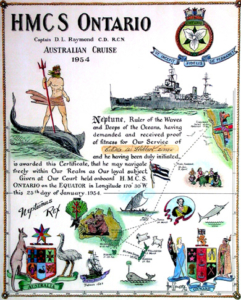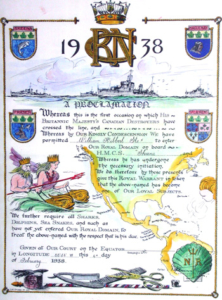The custom of marking a sailor’s first passage across important geographical parallels with a special ceremony is ancient. So ancient, in fact, that the origins of these early line crossing rites are hard to trace.
As early as 700 BC, those master mariners the Phoenicians celebrated such crossings. Human sacrifice may have formed part of their ritual, to please the sea god and ensure a safe voyage.
The ducking of initiates in water, now such an important feature of Crossing the Line festivities, may have roots in the practice of tossing a sacrificial victim overboard at moments of danger.
It is not known whether sailors who took part in these early crossing the line ceremonies received any kind of symbolic token. What is certain is that as the custom evolved over time, a tradition developed of providing participants with a keepsake to mark the event. These keepsakes not only commemorated an important occasion, but also served as proof that the recipient was tough enough to endure the hardships and hazards of life at sea.
In the Canadian Navy, one of the most tangible symbols of this rite of passage is the Crossing the Line certificate. Sons and daughters of Neptune (or shellbacks, as the initiated are known) prize these certificates since they document success in completing an important career milestone.
Modern Crossing the Line certificates are computer-generated and are not especially attractive, or memorable.
In the past, they were often beautifully illustrated and individually coloured by hand. The result was a souvenir that could later be framed and displayed with pride.
By Clare Sharpe
Museum staff member/webmaster



 CFB Esquimalt Naval and Military Museum
CFB Esquimalt Naval and Military Museum CFB Esquimalt Naval and Military Museum
CFB Esquimalt Naval and Military Museum CFB Esquimalt Naval and Military Museum
CFB Esquimalt Naval and Military Museum CFB Esquimalt Naval and Military Museum
CFB Esquimalt Naval and Military Museum CFB Esquimalt Naval and Military Museum
CFB Esquimalt Naval and Military Museum CFB Esquimalt Naval and Military Museum
CFB Esquimalt Naval and Military Museum CFB Esquimalt Naval and Military Museum
CFB Esquimalt Naval and Military Museum CFB Esquimalt Naval and Military Museum
CFB Esquimalt Naval and Military Museum CFB Esquimalt Naval and Military Museum
CFB Esquimalt Naval and Military Museum CFB Esquimalt Naval and Military Museum
CFB Esquimalt Naval and Military Museum CFB Esquimalt Naval and Military Museum
CFB Esquimalt Naval and Military Museum CFB Esquimalt Naval and Military Museum
CFB Esquimalt Naval and Military Museum CFB Esquimalt Naval and Military Museum
CFB Esquimalt Naval and Military Museum CFB Esquimalt Naval and Military Museum
CFB Esquimalt Naval and Military Museum CFB Esquimalt Naval and Military Museum
CFB Esquimalt Naval and Military Museum CFB Esquimalt Naval and Military Museum
CFB Esquimalt Naval and Military Museum CFB Esquimalt Naval and Military Museum
CFB Esquimalt Naval and Military Museum